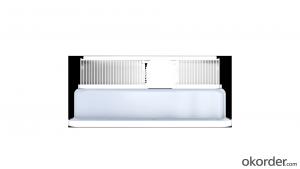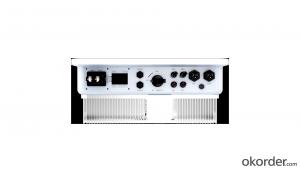3.6KW 4KW 4.6KW 5KW 6KW Single Phase Hybrid solar inverter
- Loading Port:
- SHENZHEN
- Payment Terms:
- TT OR LC
- Min Order Qty:
- 30 unit
- Supply Capability:
- 500 unit/month
OKorder Service Pledge
OKorder Financial Service
You Might Also Like
Item specifice
XD3.6kW-6kW
Single Phase Hybrid Inverter
XD3K6TL | XD4KTL | XD4K6TL | XD5KTL | XD6KTL | |
Input(PV) | |||||
Max.PV Input Power | 5.4kW | 6kW | 6.9kW | 7.5kW | 9kW |
Max.PV Input Voltage | 550V | ||||
Start-up Voltage | 100V | ||||
Rated Voltage | 240V | 270v | 300V | 330V | 360v |
MPPT Voltage Range | 100v~550v | ||||
Number of MPP Trackers | 2 | ||||
Max.PV Input Current | 16A | ||||
Output(AC) | |||||
Rated Output Power | 3.68kVA | 4kVA | 4.6kVA | 5k/A | 6kVA |
Max.Output Power | 3.68kVA | 4.4kVA | 4.6kVA | 5.5kVA | 6kVA |
Max.Output Current | 16A | 20A | 20.9A | 22.7A | 30A |
Rated Voltage | 230V | ||||
Rated Frequency | 50Hz/60Hz | ||||
THDi (@Rated Power) | <3% | ||||
Power Factor | 0.8leading-0.8lagging | ||||
Battery | |
Battery Type | Lithium, Lead-acid |
Battery Voltage Range | 40V~60v |
Max.Charge / Discharge Current | 100A |
Communication | CAN |
Efficiency | |
Max Efficiency | 97.5% |
EU Efficiency | 97.2% |
Battery Charge/Discharge Efficiency | 95% |
Protection | |
DC Reverse Polarity Protection / Insulation | Yes |
Over Current / Over Voltage Protection | Yes |
Battery Soft Start Protection | Yes |
AFCI Protection | Optional |
Surge Protection | Type ll |
Communication | |
Display | LCD |
Communication | RS485/CAN/WIFI/4G/LAN/ Bluetooth |
General Data | |
Dimension (W*H*D) | 490x 395x 200 mm |
Weight | 15kg |
Operating Temperature Range | -30℃~+60℃ |
Cooling Method | Natural |
Protection Degree | IP66 |
Max.Operating Altitude | 4000 m |
Noise | ≤25dB |
Relative Humidity | 0~100% |
Self-consumption | <10w |
Topology | High Frequency Insolation (For battery) |
MARKETING & SERVICE NETWORK
CNBM global sales team provides customers with professional and efficient pre-sale, in sale and after-sale services,
and enhances the added value of the brand with high-quality services.
Products Details:
High voltage protection Over load protection
Battery reverse connected protection Dust-proof
Low voltage protection Overheating protection
Output short-circuit protection Insect prevention



FAQ:
Q1:May I take some samples to test before placing the order ?
A1:Yes, welcome to take some sample to test!
Q2:How about the delivery time?
A2:7 days for sample; 25 days for bulk order.
Q3:What is the warranty of the controller?
A3:1 years warranty.
Q4:How to solve the technical problems?
A4:24 hours after-service consultancy just for you and to make your problem to be solved easily.
Q5:What payment methods do your company support?
A5:T/T, Western Union, Paypal, L/C etc.
Q6:What are the price terms can you offer for us?
A6:We can accept EXW, FOB, CIF and so on.
Q7:Do you have any certifications for your products?
A7:We have ISO9001:2000, CE, RoHS, certificates for all of our products.
- Q:What is the difference between a grid-connected inverter and an off-grid inverter? What are the advantages of a hybrid inverter?
- Hybrid inverter is not a clear concept, but now both energy storage dual-grid inverter does have the ability to receive control system,
- Q:Can a solar inverter be connected to a backup battery system?
- Yes, a solar inverter can be connected to a backup battery system. This allows the solar energy generated during the day to be stored in the backup battery system and used during times when the sun is not shining or during power outages.
- Q:Can a solar inverter be used in a commercial solar system?
- Yes, a solar inverter can definitely be used in a commercial solar system. In fact, solar inverters are an essential component in converting the direct current (DC) electricity generated by solar panels into alternating current (AC) electricity that is compatible with the electrical grid and can be used by commercial buildings and businesses.
- Q:What is the maximum input voltage that a solar inverter can handle?
- The maximum input voltage that a solar inverter can handle varies depending on the specific model and manufacturer. However, in general, most solar inverters can handle input voltages in the range of 150 to 600 volts DC.
- Q:How does a solar inverter affect the overall system reliability in harsh environments?
- A solar inverter plays a crucial role in enhancing the overall system reliability in harsh environments. It acts as the interface between the solar panels and the electrical grid, converting the direct current (DC) generated by the panels into alternating current (AC) that can be used in our homes or businesses. In harsh environments with extreme temperatures, high humidity, or dust and debris, the inverter's design and components must be specifically engineered to withstand these conditions. Robust protection against environmental factors ensures the inverter's longevity and uninterrupted operation. Additionally, advanced features such as temperature regulation, fault detection, and rapid shutdown mechanisms further enhance system reliability, ensuring consistent power generation and minimal downtime.
- Q:How does a solar inverter handle low light conditions or cloudy days?
- A solar inverter handles low light conditions or cloudy days by adjusting its power output to match the available sunlight. It is designed to maximize the energy conversion efficiency even in low light situations, allowing for continuous power generation from the solar panels.
- Q:Are there any safety considerations when installing a solar inverter?
- Yes, there are several safety considerations when installing a solar inverter. First, it is important to ensure that the installation is carried out by a qualified professional who is trained in handling electrical systems. This helps minimize the risk of electric shock or fire hazards. Additionally, proper grounding and insulation must be implemented to prevent electrical faults. It is also crucial to follow the manufacturer's guidelines and local electrical codes to ensure the safe and efficient operation of the inverter.
- Q:What is the maximum number of solar panels that a solar inverter can support?
- The maximum number of solar panels that a solar inverter can support depends on the specific model and capacity of the inverter. Different inverters have different power ratings and input capacities, which determine the number of solar panels they can handle. It is important to consult the manufacturer's specifications or consult with a professional to determine the appropriate number of panels that can be supported by a particular solar inverter.
- Q:How do you calculate the maximum power point voltage for a solar inverter?
- To calculate the maximum power point voltage for a solar inverter, you need to determine the voltage at which the solar panels generate the maximum power output. This is done by varying the load resistance and measuring the corresponding power output. The maximum power point voltage is the voltage at which the power output is highest.
- Q:What is the lifespan of the capacitors in a solar inverter?
- The lifespan of capacitors in a solar inverter can vary depending on several factors such as the quality of the capacitors, the operating conditions, and the overall design of the inverter. However, on average, high-quality capacitors in a well-designed solar inverter can have a lifespan of around 10 to 15 years. Regular maintenance and proper usage can help extend the lifespan of the capacitors in a solar inverter.
1. Manufacturer Overview |
|
|---|---|
| Location | |
| Year Established | |
| Annual Output Value | |
| Main Markets | |
| Company Certifications | |
2. Manufacturer Certificates |
|
|---|---|
| a) Certification Name | |
| Range | |
| Reference | |
| Validity Period | |
3. Manufacturer Capability |
|
|---|---|
| a)Trade Capacity | |
| Nearest Port | |
| Export Percentage | |
| No.of Employees in Trade Department | |
| Language Spoken: | |
| b)Factory Information | |
| Factory Size: | |
| No. of Production Lines | |
| Contract Manufacturing | |
| Product Price Range | |
Send your message to us
3.6KW 4KW 4.6KW 5KW 6KW Single Phase Hybrid solar inverter
- Loading Port:
- SHENZHEN
- Payment Terms:
- TT OR LC
- Min Order Qty:
- 30 unit
- Supply Capability:
- 500 unit/month
OKorder Service Pledge
OKorder Financial Service
Similar products
New products
Hot products
Hot Searches
Related keywords


































